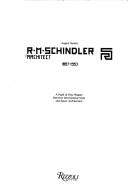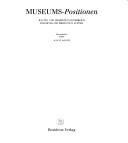| Listing 1 - 10 of 27 | << page >> |
Sort by
|

ISBN: 0847809218 Year: 1988 Publisher: New York Rizzoli
Abstract | Keywords | Export | Availability | Bookmark
 Loading...
Loading...Choose an application
- Reference Manager
- EndNote
- RefWorks (Direct export to RefWorks)
Architecture --- History --- Histoire --- Schindler, R. M. --- Rudolf Michael Schindler 1887-1953 (° Wenen, Oostenrijk ; sinds 1920 werkzaam in VS, Californië) --- Architectuur ; California ; 1ste h. 20ste eeuw ; RM Schindler --- 72.07 --- Architecten. Stedenbouwkundigen A - Z --- Criticism and interpretation. --- Schindler, Rudolph Michael, --- Schindler, Rudolph M., --- Schindler, Rudolf Michael,
Book
ISBN: 3822827711 9783822827710 Year: 2003 Publisher: Köln, : Taschen,
Abstract | Keywords | Export | Availability | Bookmark
 Loading...
Loading...Choose an application
- Reference Manager
- EndNote
- RefWorks (Direct export to RefWorks)
Selon le principe de la collection, un survol rapide de la vie et de l'oeuvre qui donne à voir et à connaître l'essentiel du sujet. L'auteur situe bien l'artiste dans son époque et met en valeur son originalité. Une chronologie complète le volume. Les reproductions d'oeuvres sont nombreuses et bien choisies. Copié du site www.amazon.fr
Loos, Adolf, --- Architecte --- Loos, Adolf --- Architecture --- Loos, Adolf, 1870-1933
Book
ISBN: 382283646X 9783822836460 Year: 2005 Publisher: Köln : Taschen,
Abstract | Keywords | Export | Availability | Bookmark
 Loading...
Loading...Choose an application
- Reference Manager
- EndNote
- RefWorks (Direct export to RefWorks)
Architecture --- History --- Histoire --- Wagner, Otto, --- Vienna (Austria) --- Vienne (Autriche) --- Buildings, structures, etc. --- Constructions --- Designers
Book
ISBN: 3854472064 Year: 1986 Publisher: Wien Wien Akademie der bildende Künste Edition Christian Brandstätter
Abstract | Keywords | Export | Availability | Bookmark
 Loading...
Loading...Choose an application
- Reference Manager
- EndNote
- RefWorks (Direct export to RefWorks)
Architecture --- History --- Schindler, Rudolph M. --- architectuur --- twintigste eeuw --- Oostenrijk --- Verenigde Staten --- Schindler R. M. --- Schindler R. M --- Schindler, Rudolph M --- Schindler, R. M. --- Schindler, Rudolph Michael, --- Schindler, Rudolph M., --- Schindler, Rudolf Michael, --- Criticism and interpretation.

ISBN: 3701707812 Year: 1992 Publisher: Salzburg Residenz Verlag
Abstract | Keywords | Export | Availability | Bookmark
 Loading...
Loading...Choose an application
- Reference Manager
- EndNote
- RefWorks (Direct export to RefWorks)
Museum architecture --- Architecture --- History
Book
ISBN: 303561878X Year: 2020 Publisher: Basel : Birkhäuser,
Abstract | Keywords | Export | Availability | Bookmark
 Loading...
Loading...Choose an application
- Reference Manager
- EndNote
- RefWorks (Direct export to RefWorks)
Der Titel des Buches setzt die beiden Tätigkeitsfelder, das Bauen und das Schreiben, des Architekten, Architekturhistorikers und Theoretikers August Sarnitz in eine wechselseitige Beziehung: im Schreiben entsteht der Kontext zum Gebauten – so wie das Bauen im Kontext des Geschriebenen steht. Eben diesem Wechselspiel folgt auch der Aufbau des Buches: einem Essay über Architekturgeschichte und Big Data folgen drei Aufsätze zu den Themen Städtebau, sozialem Wohnbau und der Fiktion des Raums. Auch einige prägende Wiener Architekten treten auf: Frank, Kiesler, Hollein und Prix. Die Themen Wohnen, Design und Möbel werden mit eigenen Projekten von Sarnitz illustriert; am Ende widmet sich das Buch der Architekturfotografie, die für Sarnitz als Publizisten große Bedeutung hat. The title of the book sets the two fields of activity pursued by the architect, architectural historian and theorist August Sarnitz – building and writing – in a reciprocal relation: the context to what has been built emerges in the process of writing, just as the context to what has been written emerges in the process of building. The structure of the book follows precisely this reciprocity: an essay about architectural history and Big Data is followed by three on the topics of urban development, social housing, and the fiction of space. A number of influential Viennese architects appear as well: Frank, Kiesler, Hollein and Prix. The topics of housing, design and furniture are all illustrated with Sarnitz’s own projects; the end of the book is dedicated to architectural photography, which is especially important to Sarnitz in his capacity as publicist. The richly illustrated book is the first to document Sarnitz’s work as author, designer, exhibition designer, architect and photographer.
Architectural Photography. --- Archtiectural Theory. --- Housing. --- Interieur. --- Urbanism.
Book
ISBN: 9783035618433 Year: 2020 Publisher: Basel Birkhäuser
Abstract | Keywords | Export | Availability | Bookmark
 Loading...
Loading...Choose an application
- Reference Manager
- EndNote
- RefWorks (Direct export to RefWorks)
The title of the book sets the two fields of activity pursued by the architect, architectural historian and theorist August Sarnitz – building and writing – in a reciprocal relation: the context to what has been built emerges in the process of writing, just as the context to what has been written emerges in the process of building.The structure of the book follows precisely this reciprocity: an essay about architectural history and Big Data is followed by three on the topics of urban development, social housing, and the fiction of space. A number of influential Viennese architects appear as well: Frank, Kiesler, Hollein and Prix. The topics of housing, design and furniture are all illustrated with Sarnitz’s own projects; the end of the book is dedicated to architectural photography, which is especially important to Sarnitz in his capacity as publicist.The richly illustrated book is the first to document Sarnitz’s work as author, designer, exhibition designer, architect and photographer.
Architecture and photography. --- Architecture --- Criticism and interpretation. --- Theory. --- 72.01 --- 72.07 --- Sarnitz, August °1956 (°Innsbruck, Oostenrijk) --- Architectuur (theorie) --- Architectuurtheorie --- Architectuur ; theorie, filosofie, esthetica --- Architecten. Stedenbouwkundigen A - Z --- Architectural photography --- Photographie d'architecture --- Philosophy --- Philosophie --- Sarnitz, August
Book
Year: 2003 Publisher: Berlin : Springer,
Abstract | Keywords | Export | Availability | Bookmark
 Loading...
Loading...Choose an application
- Reference Manager
- EndNote
- RefWorks (Direct export to RefWorks)
Book
ISBN: 3822855901 9783822855904 Year: 2007 Publisher: Köln: Taschen,
Abstract | Keywords | Export | Availability | Bookmark
 Loading...
Loading...Choose an application
- Reference Manager
- EndNote
- RefWorks (Direct export to RefWorks)
Il s'agit d'une présentation détaillée de la vie et des oeuvres les plus influentes de Josef Hoffmann (1870-1956), architecte autrichien avant-gardiste qui se situe à la croisée de l'Art nouveau et de l'Art déco.
Art nouveau --- Art déco --- Jugendstil --- Arts décoratifs --- Mobilier d'architecte --- Décoration intérieure --- Mouvement moderne --- Hoffmann, Josef --- Wiener Werkstatte --- Vienne --- Bruxelles --- Palais Stoclet
Book
ISBN: 9783836544474 3836544474 9783836544474 3836544474 Year: 2016 Publisher: Köln: Taschen,
Abstract | Keywords | Export | Availability | Bookmark
 Loading...
Loading...Choose an application
- Reference Manager
- EndNote
- RefWorks (Direct export to RefWorks)
Adolf Loos (1870-1933) fut un personnage haut en couleurs, dont la présence dans le foyer culturel qu'était la Vienne du début des années 1900 a galvanisé les constructions du pays. Défenseur précoce et passionné du modernisme, il rejeta avec force toute la démesure de l'esthétique sécessionniste qui prévalait dans l'architecture viennoise de cette époque, tout comme l'ensemble des marqueurs du style « style fin » européen.Au lieu de cela, dans ses discours et ses écrits tels que son essai majeur Ornement et crime (1908), Loos exprime sa « passion pour les surfaces lisses et précieuses ». Il défend l'idée selon laquelle l'ornementation en architecture est, par nature, éphémère, prisonnière des modes et des styles du moment, et ainsi rapidement démodée. Ce faisant, elle entraîne le bâtiment qu'elle est censée enrichir vers l'obsolescence. Loos, profondément classique, argumenta plutôt pour des constructions simples, intemporelles, à l'esthétique traditionnelle et aux qualités issues de sa structure.Devenu influent à Vienne, dans les années 1890, grâce à ses projets de commerces de détail dans la ville, Loos développa son propre style, introduisant le concept d'architecture de « plan en trois dimensions » et excluant toute frivolité en matière de décoration pour privilégier des matériaux somptueux, de haute qualité, offrant des lignes nettes. Cette introduction présentant la carrière animée et inspirante d'Adolf Loos permet de découvrir ses écrits, ses réalisations et son héritage qui perdure au fil des décennies, inspirant les styles et les générations successifs dans le dialogue constant en architecture entre esthétique élaborée et élémentaire.« L'homme aime tout ce qui lui procure du confort. Il déteste tout ce qui veut l'arracher de sa position habituelle etsûre et ce qui le bouscule. Voilà pourquoi il aime l'architecture et déteste l'art.»
Surface --- Ornement architectural --- Loos, Adolf, 1870-1933 --- Vienne
| Listing 1 - 10 of 27 | << page >> |
Sort by
|

 Search
Search Feedback
Feedback About
About Help
Help News
News